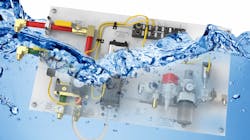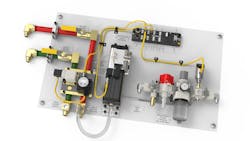Prevent Downtime: The Importance of Monitoring Water Supply and Flow During Welding
At a Glance:
- One advantage to an off-the-shelf weld water control solution is that the assembly arrives ready to integrate with piping and fittings. There should be no need to thread or fabricate any piping solutions onsite, and the system designer would have specified sensors to tailor the control and data collection needs of the end-user.
- The authors discuss three noteworthy commissioning steps of a weld water control: the connection and leak testing of the assembly pipes and tubes, commissioning of the welding process and commissioning of the entire weld cell.
- Most plants have more than one welding robot, so the potential savings multiplies when waste is reduced.
Weld monitoring can be a challenging and complex task. Good-quality repeatable welds are not only key for product durability but also the key to uptime in the weld cell. In resistance welding applications it is vital to monitor and control all welding parameters during production. One of the most critical functions to keep an eye on is the coolant supply lines. Routine equipment inspection may catch some of the supply line issues, but a turnkey, continuous monitoring system will ensure users are alerted when potential problems such as leaks occur—before it is too late.
Resistance welding has long been used in the metal forming and fabricating industry—automotive, white goods (appliances) and aerospace, just to name a few. With the ever-increasing demand to drive costs down, the pressure is on for manufacturers of these goods to streamline every step of the process. Although some stoppage to replace consumables is unavoidable in high-volume, low-cycle time resistance welding applications, stoppage for coolant system failure and the resulting repair, cleanup and cell reset can be one of the more costly events.
Leaks, supply line failure, melted welding tips and a myriad of other things can go wrong in the coolant supply system within the weld cell and it is vital to have monitoring and feedback in place to act accordingly. Furthermore, the safety implications of spilled coolant in the work cell speaks for itself.
Custom Solution vs. Pre-engineered System
Current marketplace solutions are typically patched together by an integrator or the end-user and built on site. Often, custom solutions require a dedicated Ethernet connection or are a multi-component solution that needs a PLC or robot to function. Many Ethernet-dedicated solutions are not field serviceable; the entire solution must be replaced. A component solution is not designed to be a system, so the serviceability is a function of the designer, whose role invariably does not include maintaining the equipment.
The advantages to an off-the-shelf solution start the day the assembly is ordered—especially if the system incorporates IO-Link. The assembly shows up at the plant ready to integrate with piping and fittings—there should be no need to thread or fabricate any piping solutions onsite. Furthermore, the system designer can specify a myriad of sensors to tailor the control and data collection needs of the end-user.
There are three noteworthy commissioning steps of a weld water control system: connection and leak testing of the assembly pipes and tubes, commissioning of the welding process and commissioning of the entire weld cell. During the connection and leak testing of the assembly pipes and tubes the system can be tested using the onboard pushbuttons and user interface to set flow and pressure parameters. There is no need for a PLC programmer to integrate the system, so the weld water monitoring system can be plumbed into the plant.
This advantage also holds true during the setup of the resistance welding process. Adjustments can be made to the pressure and flow of the system without the need to have the controls engineer present. Finally, the controls engineer can use the predefined interface to quickly commission the weld water control system into the PLC to orchestrate all the moving pieces within the work cell.
Monitor Critical Process Parameters Simultaneously
Once commissioned, the weld water control system offers several features including tip off (lost tip), insufficient flow and the capability to monitor all variables in the process. If any decrease in flow is sensed by the system, the weld water control system will stop the incoming flow from the pump or plant sourced coolant supply line and attempt to syphon the existing coolant out of the system return lines to minimize or eliminate any coolant that will spill onto the floor. Flow, pressure, temperature and several control variables are available over a single IO-Link connection that allows operations to collect and analyze detailed insights into process parameters. Gathering metrics from ancillary systems such as pneumatic pressure and weld current give the operators a full picture of the welding process and put them in control of the system.
Cost and Time Savings Add Up—Less Coolant Waste
While individual monitoring at the point of use certainly offers cost savings, the real money savings are realized when looking at the entire coolant system in a facility. Most plants have more than one welding robot, so the potential savings multiplies when waste is reduced. Water is a critical resource in many countries. If the user can now more closely track the amount needed in each cell, it will make welding operations more efficient and save water. Energy savings and energy efficiency are also potential advantages of a weld water monitoring system.
Safety Considerations
A weld water monitoring system also allows users to catch potential leaks sooner, preventing spills of chemicals and glycol solutions. Once a spill occurs, the cell must be disabled for maintenance workers to enter the cell and clean up the spill. Not only is downtime costly but the presence of liquids on the floor of the work cell presents a slip and fall hazard even to trained personnel. Another safety consideration is to monitor the system in case of a fault that would cause the liquid coolant to fall below the designated threshold. Helping to protect expensive robotic welding systems from overheating reduces the likelihood of damage and other hazards.
Turnkey Advantage
The key factors to consider are water savings, improved process control, proactive alerts and better diagnostic tools. Using an off-the shelf systems solution to implement a weld water control system makes more sense from a financial and safety perspective. With a turnkey system the end-user can realize gains including decreased commissioning time and complexity as well as the ability to capture process variables from individual systems in one interface.
Kyle Hall is a senior product engineer and Tim Ritter a business development manager for Turck, a manufacturer of sensors, connectivity and fieldbus technology for factory, logistics and process automation.

